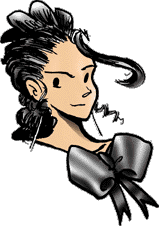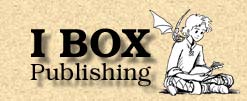Nov 5th, 2001 -
5:03 A.M.
Hey, Everybody! Time for another long awaited column!
--But first, just in case any of you out there might be
new to this site and to my work in general, I should explain that the little
cartoon portrait of the lady directly above is Soracia, the Shadow Queen;
one of the characters in Thieves & Kings. The reason I mention
this is that as I was putting the final touches on this edition of the
web comment in the early morning hours, it struck me that the cartoon happens
to be placed exactly where a columnist's little photo might normally appear
in a newspaper. Which makes me think that it might be a cool idea to put
a little shot of myself there one day, (just like a real columnist). But
not tonight, cuz I'm just about to fall asleep at the keyboard. Soracia
will have to stand in for now. (Though, I expect her editorials would be
a touch more caustic than mine.)
So anyway, IT is finally off to press!
The fourth trade paperback is going to make it out about
a month before the Big Papa of annual holiday seasons. And so all the comic
shop owners and book retailers who have been calling me with ever increasing
tension in their voices can all relax. It's off to press, and there will
be many shopping days left before the end of the year festivities.
But boy, oh boy! I don't mind saying that this latest
book was a LOT of work. I was swimming in bits of clip-art and edited pages
and new material of various sorts. Holy smokes! I felt like I was drowning
at times! I've never dealt with so much material before. I actually needed
every minute of the two months I'd set aside to work on the thing. Quite
the project.
But it's done now! Hooray!! And if you were here, you
could witness me doing the little poombah dance I do whenever I close a
file folder on another project and see the FedEx guy drive away with a
package destined for the good people at Quebecor Printing. This one very
nearly killed me! TPB's are murder. (At least the way I like to do them.)
The very first book I put out was the most amazing in
this regard. A total adventure! That was before I had a computer, and the
cover I needed to make was far too complex for me to be able to get by
with my weird animation cell solutions. --That is, the date, price and
issue number rubbed down with Letraset letters on a sheet of clear plastic,
then overlaid on the cover painting. I would send stuff like that off to
press and demoralize and confuse the poor people in pre-press departments
everywhere. I didn't know what the heck a spot color process was back then,
and to be honest, I still don't. Having missed that class at illustration
college, (er, make that, having missed illustration college), I didn't
know anything about how stuff got printed in the real world, so I had to
make up my own methods. Luckily, they worked just fine. -Although, I was
a little worried that my supply of white Letraset letters would run out
before I was ready to jump into the digital realm. --Letraset, you see,
was quickly going out of business as the world realized that a cheap laser
printer could do with no effort what Letraset allowed people to do at great
expense and with lots of eye straining labour. Letraset, in an effort to
cut costs as their once mighty ship began to list dangerously in the seas
of economic change, had some time earlier stopped producing the white rub
down letters I required; I'd found the sheets I needed in one of those
bargain boxes at the foot of the cash register. "Wow! Perfect!" I'd thought
at the time. "I can use these to demoralize pre-press departments with
unconventional solutions to problems which have already been solved in
much more efficient ways but which I am far too stubborn to learn properly!
Cool!"
-I only needed the numbers and the few letters from
each sheet to spell things like, 'Sep', 'May' and 'Iss#'. And I quickly
ran out of the '#' symbol. I used to create my own symbols out of spare
letters.
Gads. What a claptrap system! At least it worked.
Anyway, the first collected volume was a whole other story.
It needed text on the back, inset images and logos on the spine, and the
cover had to look great. The mere thought of trying to create the whole
thing at full size from pasted clip art and rub down letters, all to be
shrunk down directly to film, gave me a head ache. It would have looked
awful! So I bit the bullet and marched out to Richmond St, (which at the
time was two blocks away from where I lived).
Now, Richmond street is about as ugly as they come. It's
a dusty downtown road with too much sunlight and too few trees, just a
couple of blocks south of the bad part of town. But it was, and for all
I know, still is where all the graphics and photo labs live. Any print
film job you want done can be done on Richmond St.
So I marched down there with my painting for the Red Book
under my arm and a list of questions written down. And I seem to recall
being extraordinarily tired, so my eyes probably had bags under them and
my stomach was probably feeling all knotted up. -Believe it or not, making
comics the way I make them, with detailed backgrounds and lots of finicky
text editing and such, especially back then when it took me ten tries to
get things right, well. . , let's just say that I didn't get very much
sleep in those days.
Anyway, I marched down there in a heap of coffee doused
nerves with my art bag in hand and asked the first guy, (I seem to recall
his name being 'Don'), how the heck I was supposed to turn my stack of
clip art and paintings into a cover, because I'd run screaming from college
and started up a publishing company before the professors got to that lesson.
Don laughed and talked me through it. It seemed that you
couldn't do the whole job at just his place. Indeed, a job like mine required
a graphics lab to scan my work, a guy who knew how to use some program
called, 'Adobe Photoshop,' and then a lay-out guy to put the whole thing
together and save it to disk. He gave me a list of names of people along
Richmond street who I should see. I frowned and asked why all of this stuff
couldn't be done at his place. (The oft heard cry of the artist, "Damn
it! I don't want to run around trying to learn all this stuff! I just want
to drop my pages off at one place and have somebody else take care of it
for me!" -The way, incidentally, that most artists find themselves getting
ripped off.)
Don laughed again and explained it to me. "Well, if you
like, I can do it all for you. But I'd only be running around to all these
different people myself, and I'll charge you way too much for my time and
for the wear on my shoes. Plus I can practically guarantee that with so
many people involved that whatever we come up with will probably not be
exactly as you envision it. Nobody cares about this job more than you.
Everybody else just wants to go home with a paycheck at the end of the
month."
"Yeah. Great. Okay. Thanks Don," I said glumly, and paced
out, still jittering from too little sleep.
As it happened, I went back later that week to thank Don
for his help, because running around doing all that stuff myself turned
out to be a great experience. I met a lot of neat people over the next
few days and learned a ton about how to lay out books. And it was a lot
faster and a heckuva lot less expensive than the college course I would
have had to have taken, (and which, incidentally, wasn't even offered in
the prestigious three year illustration program I'd barely managed to escape
from with my life and brain intact). Though there were also a lot of heart
stopping complications Don didn't warn me about. Not to mention, I was
on a really, really tight schedule. It was Wednesday, and this thing had
to ship Friday afternoon at the latest. I had a convention I was flying
to on Friday evening, so all problems were magnified.
-See, computer assisted layout and publishing back then
was still just getting off the ground. We didn't have CDR technology, and
we didn't have lots of cheep computer memory. We didn't even have those
dorky 100 meg Zip disks. Everybody, it seemed, was using a different kind
of removable hard drive cartridge to save stuff on. 80 Meg disks which
cost over a hundred dollars each. And I nearly ended up needing more than
one type just to move files up and down Richmond Street. At one point the
fellow from the graphics lab where they had scanned my cover painting hiked
with me across the street with their company disk drive and we spent a
couple of hours with the Photoshop guy installing the thing on his system
just so we could open the files the first guy had made. -A silly complication
in this, one of the largest, most advanced cities in the world. This is
what happens when one way of doing things dies out and another is born.
What a ridiculous time! What fun!
Well, that was 1996. Not a very long time ago, but as
I sit here in front of my dinky, out of date PC, (which could nonetheless
mock and spit dust at the computers being used on Richmond street back
then), I find myself contemplative. The change has been fast, and making
comics has become a lot less painful. And I am getting more sleep, which
is a good thing.
Although. . .
I'm really glad I got to live through those sorts of adventures.
-Indeed, I seek stuff like that out still. Life just isn't as much fun
when it comes with push-button convenience.
So anyway. . .
The new TPB!
I am very, very pleased with it. It's huge. At 272 pages,
it's quite a bit longer than the Green Book, which was a big book. So I'm
having Quebecor print it on a slightly thinner, less toothy paper stock,
just to make the shipping and warehouse troubles less so. In any case,
it's going to be a very pretty book, with a number of neat-o extra features.
It ties up three story threads, and in fact, the new story
arc which starts with the very next issue, (#37), will begin one year of
story time from where the last issue left off. (Didja follow that?)
Look for issue #37 on the racks in January.
And look for the Shadow Book by the end of November!
Take care!
-Mark
|

